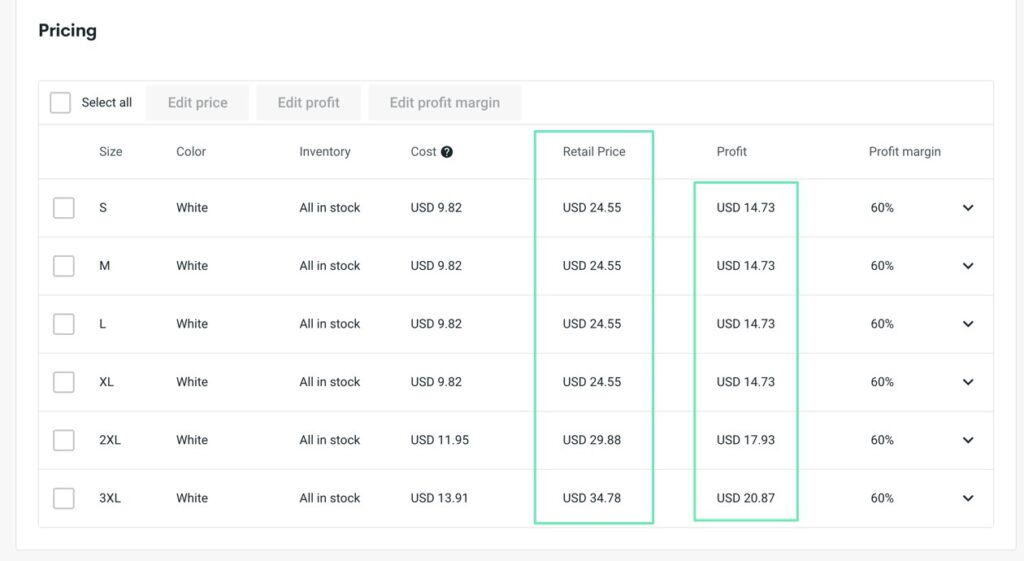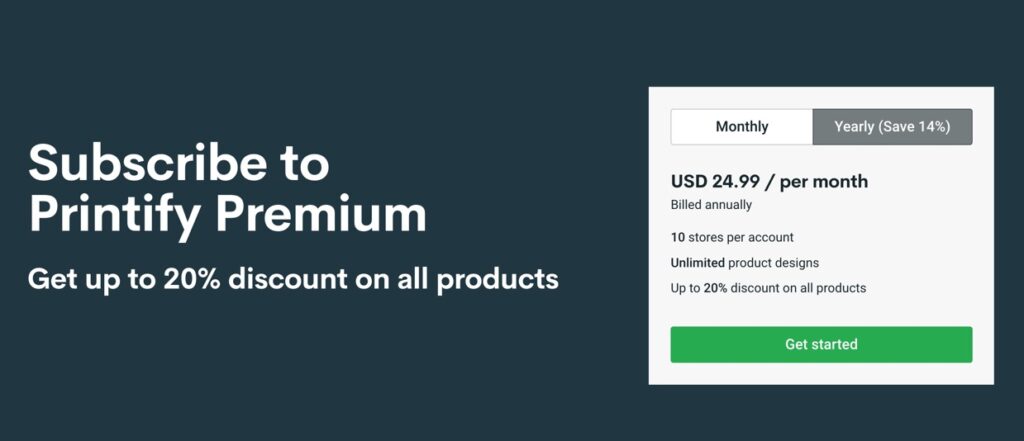Understanding Printify’s Production Costs
Printify is a popular print-on-demand platform that enables sellers to create and sell custom products without holding any inventory. As a seller, understanding Printify’s production costs is crucial to determining your pricing strategy and ensuring profitability. The question on every seller’s mind is: how much does Printify charge for production? In this article, we will break down Printify’s pricing structure and provide insights into the factors that affect their production costs.
Printify’s production costs are influenced by various factors, including the type of product, material, size, and shipping destination. For instance, the cost of producing a t-shirt is different from that of a mug or a phone case. Additionally, the cost of shipping products to different regions also varies. To give you a better understanding of Printify’s pricing, let’s take a closer look at their production costs.
Printify’s production costs are typically lower than those of traditional printing methods, making it an attractive option for sellers who want to offer custom products without breaking the bank. However, it’s essential to note that Printify’s prices can fluctuate depending on the product and shipping destination. As a seller, it’s crucial to stay up-to-date with Printify’s pricing changes to ensure you’re not losing money on your sales.
So, how much does Printify charge for production? The answer lies in their pricing structure, which we will explore in more detail in the next section. By understanding Printify’s production costs, you can make informed decisions about your pricing strategy and maximize your profits.
How Printify’s Pricing Works: A Step-by-Step Explanation
Printify’s pricing structure is based on a combination of factors, including the type of product, material, size, and shipping destination. To understand how much Printify charges for production, it’s essential to break down their pricing process into individual components. Here’s a step-by-step guide on how Printify calculates its prices:
Step 1: Product Selection – Printify offers a wide range of products, from apparel and accessories to home decor items. Each product has a unique base price, which serves as the foundation for the final production cost.
Step 2: Material and Size – The type of material and size of the product also impact the production cost. For example, a t-shirt made from high-quality cotton will cost more to produce than one made from a lower-grade material.
Step 3: Printing Method – Printify uses various printing methods, such as direct-to-garment (DTG) and sublimation, to produce its products. Each printing method has its own set of costs, which are factored into the final production cost.
Step 4: Shipping Destination – The shipping destination also plays a significant role in determining the final production cost. Printify charges different shipping rates depending on the location, which can impact the overall cost of the product.
By understanding these individual components, sellers can better estimate how much Printify charges for production and make informed decisions about their pricing strategy. In the next section, we’ll take a closer look at Printify’s base prices for various products.
Printify’s Base Prices: What You Need to Know
Printify’s base prices are the foundation of their pricing structure, and understanding these prices is crucial for sellers who want to calculate their profit margins accurately. Printify offers a wide range of products, including apparel, accessories, and home decor items, each with its own base price.
For example, Printify’s base price for a standard t-shirt is around $8-$10, depending on the material and size. For hoodies, the base price is around $15-$20, while for mugs, it’s around $5-$7. These prices are subject to change, so it’s essential to check Printify’s website for the most up-to-date pricing information.
Here are some examples of Printify’s base prices for popular products:
- T-shirts: $8-$10
- Hoodies: $15-$20
- Mugs: $5-$7
- Phone cases: $10-$15
- Posters: $15-$25
Keep in mind that these prices are only the base prices, and additional costs such as shipping, taxes, and payment processing fees will be added to the final production cost. In the next section, we’ll discuss these additional costs and provide tips on how to minimize them.
Additional Costs to Consider: Shipping, Taxes, and More
While Printify’s base prices are an essential part of their pricing structure, there are additional costs that sellers need to consider when using the platform. These costs can add up quickly, so it’s crucial to understand what they are and how to minimize them.
Shipping costs are one of the most significant additional costs associated with Printify. The cost of shipping varies depending on the destination, package weight, and shipping method. Printify offers a range of shipping options, including standard, expedited, and express shipping. Sellers can estimate shipping costs using Printify’s shipping calculator tool.
Taxes are another additional cost that sellers need to consider. Printify collects sales tax on behalf of the seller, but the seller is responsible for paying any applicable taxes on their earnings. The tax rate varies depending on the seller’s location and the type of products being sold.
Payment processing fees are also an additional cost associated with Printify. The platform charges a payment processing fee of 2.9% + $0.30 per transaction. This fee is deducted from the seller’s earnings, so it’s essential to factor it into the pricing strategy.
To minimize these additional costs, sellers can consider the following strategies:
- Offer free shipping on orders over a certain amount to reduce shipping costs.
- Use Printify’s shipping calculator tool to estimate shipping costs and adjust pricing accordingly.
- Consider using a third-party shipping service to reduce shipping costs.
- Factor payment processing fees into the pricing strategy to avoid losing money on transactions.
By understanding these additional costs and implementing strategies to minimize them, sellers can maximize their profits and achieve success on the Printify platform.
How to Calculate Your Profit Margins with Printify
Calculating profit margins is a crucial step in determining the success of your Printify store. To calculate your profit margins, you need to consider the production costs, shipping costs, and other expenses associated with selling products through Printify.
The formula for calculating profit margins is:
Profit Margin = (Selling Price – Production Costs – Shipping Costs – Other Expenses) / Selling Price
For example, let’s say you’re selling a t-shirt through Printify with a selling price of $25. The production cost of the t-shirt is $10, and the shipping cost is $5. You also need to consider other expenses such as payment processing fees and taxes.
Using the formula above, your profit margin would be:
Profit Margin = ($25 – $10 – $5 – $2) / $25 = 32%
This means that for every $25 you sell, you’ll make a profit of $8.
To maximize your profit margins, it’s essential to consider the following strategies:
- Set competitive prices for your products to attract more customers.
- Choose products with low production costs to increase your profit margins.
- Optimize your shipping costs by using Printify’s shipping calculator tool.
- Minimize other expenses such as payment processing fees and taxes.
By understanding how to calculate your profit margins and implementing these strategies, you can maximize your profits and achieve success on the Printify platform.
Comparing Printify’s Prices to Other Print-on-Demand Platforms
Printify is not the only print-on-demand platform available, and it’s essential to compare its prices to other popular platforms to determine which one is the best fit for your business. In this section, we’ll compare Printify’s prices to those of Redbubble, Teespring, and Society6.
Redbubble is a popular print-on-demand platform that offers a wide range of products, including apparel, accessories, and home decor items. Redbubble’s prices are generally higher than Printify’s, with a base price of $15 for a standard t-shirt. However, Redbubble offers a more extensive range of products and a more comprehensive shipping network.
Teespring is another popular print-on-demand platform that offers a wide range of apparel products. Teespring’s prices are generally lower than Printify’s, with a base price of $10 for a standard t-shirt. However, Teespring’s shipping costs are higher than Printify’s, which can eat into your profit margins.
Society6 is a print-on-demand platform that specializes in home decor and wall art products. Society6’s prices are generally higher than Printify’s, with a base price of $20 for a standard poster. However, Society6 offers a more extensive range of products and a more comprehensive shipping network.
Here’s a summary of the prices for each platform:
| Platform | Base Price (T-Shirt) | Shipping Cost (T-Shirt) |
|---|---|---|
| Printify | $8-$10 | $5-$7 |
| Redbubble | $15 | $10-$15 |
| Teespring | $10 | $15-$20 |
| Society6 | $20 | $15-$25 |
As you can see, each platform has its own strengths and weaknesses when it comes to pricing. Printify’s prices are generally lower than those of Redbubble and Society6, but higher than those of Teespring. However, Printify’s shipping costs are generally lower than those of Teespring.
Ultimately, the choice of platform will depend on your specific business needs and goals. It’s essential to compare the prices and features of each platform to determine which one is the best fit for your business.
Optimizing Your Printify Store for Maximum Profit
To maximize your profits on Printify, it’s essential to optimize your store for maximum efficiency. Here are some tips to help you optimize your Printify store:
1. Pricing Strategy: Set competitive prices for your products to attract more customers. Use Printify’s pricing calculator to determine the optimal price for your products.
2. Product Selection: Choose products that are in high demand and have a low production cost. Use Printify’s product research tool to find the best-selling products.
3. Marketing Strategy: Develop a marketing strategy that targets your ideal customer. Use social media platforms, email marketing, and influencer marketing to promote your products.
4. Product Design: Create high-quality product designs that appeal to your target audience. Use Printify’s design tool to create custom designs for your products.
5. Customer Service: Provide excellent customer service to build trust and loyalty with your customers. Respond to customer inquiries promptly and resolve any issues quickly.
By following these tips, you can optimize your Printify store for maximum profit and achieve success in the print-on-demand market.
Additionally, consider the following advanced strategies to take your Printify store to the next level:
- Use Printify’s API to automate your store’s operations and streamline your workflow.
- Integrate your Printify store with other e-commerce platforms, such as Shopify or WooCommerce.
- Use Printify’s analytics tool to track your store’s performance and make data-driven decisions.
By implementing these strategies, you can maximize your profits and achieve long-term success on Printify.
Conclusion: Mastering Printify’s Pricing for Success
In conclusion, understanding Printify’s pricing structure is crucial for success in the print-on-demand market. By breaking down Printify’s pricing structure and understanding the factors that affect production costs, sellers can make informed decisions about their pricing strategy and maximize their profits.
Remember, Printify’s pricing structure is complex and influenced by various factors, including product type, material, size, and shipping destination. By considering these factors and using the tips and strategies outlined in this article, sellers can optimize their Printify store for maximum profit and achieve long-term success in the print-on-demand market.
Additionally, it’s essential to stay up-to-date with Printify’s pricing changes and adjust your pricing strategy accordingly. By doing so, you can ensure that your Printify store remains competitive and profitable in the ever-changing print-on-demand market.
By mastering Printify’s pricing structure and implementing the strategies outlined in this article, you can unlock the full potential of your Printify store and achieve success in the print-on-demand market.
So, how much does Printify charge for production? The answer is complex and influenced by various factors. However, by understanding Printify’s pricing structure and using the tips and strategies outlined in this article, you can make informed decisions about your pricing strategy and maximize your profits.








